Since its release, we have covered the topic of Mituso Iso’s anime The Orbital Children numerous times through interviews. With the release of our interview with the show’s character designer Ken’ichi Yoshida, we thought that would be it. That was before learning about Ilya Kuvshinov’s venue to Japan Tours Festival, an event in France that we love attending each year. We were already planning on going, but being able to interview Ilya Kuvshinov was the icing on the cake, allowing us to go one step further in our coverage of the spiritual successor to Dennou Coil.
Ilya Kuvshinov has been working in Japan for nearly ten years, first in video games and now in anime, having worked with genius directors such as Keiichi Hara and Mitsuo Iso. With each work, Ilya is getting more and more responsibilities and even made his directing debut last year by directing the Music Video to the Cyberpunk: Edgerunners ending. Learn more about all that in our interview.
Like our content? Feel free to support us on Ko-Fi!
Thank you for accepting this interview. When we interviewed Mitsuo Iso in 2017, he already told us you were working on The Orbital Children. And so I wanted to ask, who was the first Japanese director you started working with? Was it Keiichi Hara or Mitsuo Iso?
Ilya Kuvshinov: It was Keiichi Hara, and the thing is, when we started working together on Birthday Wonderland, Mitsuo Iso was also there. He was at Signal.MD and had this little room, so we talked a lot. Bahi JD was also there; everybody was at Signal.MD for some reason. We moved here and there until Mitsuo Iso moved to his other studio. He was always there, talking to us about his project, showing us the sketches, and asking, “What do you think about the story?” He took a big interest in how young people may perceive the story of The Orbital Children. Generational differences, how my and his generations think differently about moving to outer space, what the problems could be… Looks like he had been thinking really hard about the story for The Orbital Children for years.
Did he ask about your opinion also as a foreigner? Space doesn’t have borders, after all. Was he also interested in that?
Ilya Kuvshinov: Yeah, in his mind, I believe, Japanese people feel so comfortable in Japan; they don’t really need to go anywhere else. And that’s how the earthlings think about Earth and outer space. Earth is good enough; why would we move there? It’s scary and cold, and there’s nothing there, something like that. So he thought: What’s the difference between a Japanese person thinking about moving out of this beautiful, small place, with communities and people you know and love, and people from other countries thinking about moving to other countries, other spaces? Trying new horizons and stuff like that. He was really into researching all of that. What do people think? He’s doing his very best to understand the different viewpoints on that.
At this point of the production, when he was asking about your opinion, how many people were involved?
Ilya Kuvshinov: I think the first time I saw something from The Orbital Children, it was Mitsuo Iso and Mr. Yoshida, scripts and some designs and sketches by Mitsuo Iso, and characters and props from Ken’ichi Yoshida. Just a few of them, I believe.
When was that, approximately?
Ilya Kuvshinov: It was around 2017, 2018, when we were at Signal.MD.
And when did you first start to work on it?
Ilya Kuvshinov: When Birthday Wonderland ended, I still had my desk at Signal.MD, even my PlayStation was still there, lots of stuff. Fuminori Honda, the producer that founded Production +h., asked me if I could help with Psycho-Pass 3, as they needed some animation supervising and key animation for the series, so I went. Ken’ichi Yoshida was also there, and Mitsuo Iso as well. As I worked on Psycho-Pass 3, Mitsuo Iso asked me if I was interested in trying some design for The Orbital Children, and I was willing to give it a try. It started with me, Fuminori Honda, and Mitsuo Iso sitting together with a producer and a 3D artist. We were a little bit more now; there was the person that did all the Blender models of the space station, the elevator, and stuff like that. Ken’ichi Yoshida was present at meetings as well, doing designs while we talked.
From this first step to the end product, were there big changes you saw?
Ilya Kuvshinov: It was changing and whirling a lot. I was doing some designs at first, and then I did storyboards for the second episode. On the second episode, the thing was that we hadn’t yet gotten the station layout, and we hadn’t decided on a lot of things, so I was doing designs and storyboarding at the same time. Like, “This part is now changed, we need to redo this”, so it’s always whirling, going up, changing, rotating, at the same time designing itself, polishing the story, the character changed names, the clothing changed. The robots, too, changed a lot. So it was like a tree needing to change its shape because some electric pole is in the way, and the roots need to go around it. It wasn’t like, “so here’s the script, the storyboards, let’s just animate it.” It was all at the same time. Designs, storyboards, and animation at the same time. A very unique approach, I think.
How was it decided to let you do the storyboard?
Ilya Kuvshinov: Mitsuo Iso was looking at my designs and said, how about we give you storyboards? I don’t know where it came from, but it was always my dream to do storyboards for animation. When I was a kid, my best way to spend time was reading books, and what I loved about them was the freedom to create the pictures in my head, the characters, how they talk… All of this stuff, you imagine it, you hallucinate in your head. When you do a storyboard, you read the text and you draw what you imagine, so I love it. And it’s an original animation, so we only have text. We would have long meetings, where Iso would read the scenario and explain what such scenes mean, the characters, and their connections to each other. What’s the space station’s structure like? He was doing little sketches showing up, like, this will be like that… I had more than twenty pages of Mr. Iso’s sketches, so basically, he had done the storyboard; I just needed to put it on timing, put the dialogues here and acting there, and stuff like that. It was a long process. The second episode was actually nearly 45 minutes, and we needed to cut a lot. We put some things from the second episode to the fourth one. When they put flowers in front of the crater, it was in the second episode at first, in the beginning, but they moved it to the fourth one I believe.
You said it’s your first storyboard for a TV series. What animation did you storyboard before?
Ilya Kuvshinov: Before, back in Russia, I was directing a motion comics series. Motion comics are basically set pictures, but they’re moving a little. You swipe the page, and the characters go like “woosh,” and the bubbles are like “pop, pop, pop!” Directing that, I did storyboards for it, but it’s nothing like a real storyboard. So I was slowly getting at there. My first storyboards for real productions were on anime. I was doing the ending for Sing Yesterday For Me, the ending for Ghost in the Shell: SAC_2045, ending animation for The World Ends with You, mostly endings. They were my first tries. But the real thing, with 24 minutes of characters interacting, was The Orbital Children. You need to think about where they are in space, where to put the camera, show the station, show how they run around, and stuff like that. It was super hard for a first time trying that, especially since The Orbital Children is not your normal anime about high-schoolers going to school or to a Shinto shrine… It’s in zero gravity; they’re floating and shit! There are robots, there are new technologies we don’t know, machines using your portable bottle and more. It was challenging, but I learned a lot.
Since it was your first time storyboarding a whole episode, did you get any help? Especially as Mr. Iso can be very controlling…
Ilya Kuvshinov: We spent hours and hours on the meetings, then I spent months on the storyboards, submitted it, and that was it There were things I didn’t fully grasp, for example, why the camera is moving like it is moving. So I learned a lot. In the end, the second episode is mostly Mitsuo Iso’s storyboard, but they were still kind enough to put me in the credits. A couple of months ago, they released the Blu-ray version, and they have a little storyboard book of the second episode. It was all the second episode, and then they actually put my part of the original storyboard, the scene with the flowers. At the end of the book, there were comments by Iso. He wrote, “Working on the second episode’s storyboard was a grueling task because we didn’t have all the designs down, but thanks to Ilya’s young passion, we have done it.” He said he was thankful for me not running away from this hard project. My heart felt so warm about it because all I felt during production was, “I’m not good enough. He redrew all of my stuff; maybe I’m not really suited to this industry; I’m bad at that.” In the end, I realized I’d done a lot of foundation that helped Mitsuo Iso not spend a lot of his time doing everything from zero. He redrew all of this, but I think it’s like doing animation. We get the animator’s layout and redraw it, but still, the structure and the timing are there… So it was like that. I was feeling so bad about the second episode’s storyboard, as I spent months on that, and Iso spent months redrawing that as well. I thought I made them lose so much time… but after this comment on the storyboard book in a Blu-ray box, I realized it wasn’t like that. They were actually thankful for that.
On the second episode, more foreign animators worked on it. Did you bring them in, or is it just a coincidence?
Ilya Kuvshinov: I just did the storyboard, I’ve done animation myself for the second episode as well as the fourth, but I didn’t recommend animators.
So it’s just a coincidence that it’s on your episode?
Ilya Kuvshinov: Yes. But I can’t really say the second episode is my episode because it was redrawn.
You didn’t get involved with after-recording or things like that?
Ilya Kuvshinov: I was on the storyboard, but I wasn’t doing direction on this project. Just the storyboards that I gave them, and after a couple of months, they asked me if I wanted to animate for this episode, and I was happy to help. I wasn’t doing the preparatory meetings or after-recording, just storyboarding. But right now, I’m working on a project at Production +h., I’m in charge of much, much more, so please look forward to it!
Regarding the animation you did on the second episode, the animation director was Toshiyuki Inoue, a legend.
Ilya Kuvshinov: He is awesome. He also worked on Lonely Castle in the Mirror for Keiichi Hara; he was there as well. So it was great timing to have him on The Orbital Children, then on Lonely Castle in the Mirror. I’ve done the design of the castle on this title.
May we know what your inspiration for the castle was?
Ilya Kuvshinov: It was mostly the German ones… I forgot the name. I was in Frankfurt for the Book Fair. And there was a really old German castle there, there was like a museum exposition, so I walked around shooting pictures, that was fun and helped a lot.
Back to the topic of the animation, did you get any corrections from Mr. Inoue? If you did, how did you feel? Were you learning from them?
Ilya Kuvshinov: My cuts were corrected by Mr. Yoshida. I always liked to look at what changed. When I’m doing key animation, I’m trying to get as close to the original designs as possible, but it’s still me, especially the noses; they get a little bit bigger. It was corrected by Mr. Yoshida; it was a learning opportunity. It’s always fun for me to see what changed, how they’re thinking, and how the shapes work in their head.
Were you working with them in the same room?
Ilya Kuvshinov: Yes, Mr. Yoshida was sitting with me, and we were talking a lot, maybe too much, about designs, and the usual things, bikes, food, anime, anything really.
What did you think about Mr. Yoshida’s designs? Since you’re also an illustrator and character designer, I’m interested in your opinion about what’s most appealing about them.
Ilya Kuvshinov: The shapes, how expressive the poses are. I don’t even think I can do anything like that because my learning style of how to draw characters is by making them look like they’re 3D but still drawing them with lines. It’s about the shapes moving around. But Mr. Yoshida’s drawing is about the expressiveness of the poses of the motions. It’s impossible for me to do something like that, but I can try. So when he draws on top of my drawing, it’s not like I was wrong, but I can see how he’s thinking about the same situations with the same characters. So it’s really cool to work with people like that.
It’s also one of the best ways to progress.
Ilya Kuvshinov: It is. Even Mr. Honda said, you have layout animation, then the animation director drawing on top of it, but then you don’t give it to the layout animator, but the second key animator; this is the best way not to learn anything. If the first layout animator gets fixes from the animation director and does animation on top of it, he learns. If the second key animator comes in, nobody learns anything. But sometimes, we don’t have enough time to do the second key animation ourselves.
On another topic, Mr. Hara is the first director you worked with. He’s a very emotional person. He can talk about a movie while being angry or crying and then switch to laughing all in two minutes. Can you tell us how it was, working with such a character?
Ilya Kuvshinov: He is really kind around the staff. When I started working with him, I wasn’t very good at Japanese, and he was trying to talk to me in English. Explaining things, showing photos. A bit as if I were a kid doing bad, he’d be like, it’s okay, don’t worry about it. As a human being, he’s one of the best I’ve ever met. To work with a person like that is great, of course. I’m happy my first collaboration with a Japanese director was with director Hara because, after that, I realized that it’s how I want to be. That’s how I wanna treat the people I work with, how I treat the work itself, the original working basis. How detailed I could be with things, and how some of the things are better entrusted to animators because they know their stuff. There’s teamwork, but it still needs someone to direct it, and there’s a way to direct it. Not to force it, but to see the best in each person you work with and make them shine. He could see what’s good in a person and give them freedom. That’s why he gave me freedom for a lot of designs and things like that. He also gave freedom to animators. For example, he would draw this storyboard, and the animator comes and asks, how about we change things like this so it’d be funnier and maybe more emotional, and Keiichi Hara would answer, yeah, you should do that. Never anything like “No! Just draw as I drew!”. He listens to everybody. Even the production assistants, when anybody suggests “How about we make it like this or that?”, he always hears them out and provides an opinion. “It looks like it’s not gonna work,” or “Yes, it’s actually a really good idea!” He is the best example I could have for my first working experience. I learned a lot and want to be like him.
When I met him at Annecy this year, I was really shocked because he went on a rant about busy animators, paid but working on other projects, not doing work for which they were paid.
Ilya Kuvshinov: It’s more important to be nice to staff than make money. I think it’s all about the experience. Of course, when we work on the movie, we are creating an experience for the viewer, but it should also be a great experience for the people working on the production as well. Maybe he’s too kind sometimes, but it’s for everyone’s sake. He doesn’t do it only for the viewer but also for us, people that are drawing thousands of drawings. He’s really cool.
I wanted to ask more about the music video you did for the ending of Cyberpunk: Edgerunners. That way, we will have talked a bit about all your recent news. How did it happen?
Ilya Kuvshinov: I was really into this new Cyberpunk 2077 game and wondered if I could be part of it in any way. I have a friend, Suzi Hunter, who told me she has some contact at GOG; it’s CD Projekt’s Good Old Games platform. So she contacted them, and they gave her the contact of someone in charge at CD Projekt Red. Then they contacted me, and I asked, “Can I help with anything for the game?” They replied, “Unfortunately, we don’t have time to do any new content.” So I suggested to use my fan arts of The Witcher and Cyberpunk 2077 for official goods. And they were okay with that. And just in case I was like, “By the way, I heard Studio Trigger is doing the Cyberpunk anime, right? Can I help somehow?” They told me that the studio was doing everything in-house. But they had this idea about taking the ending song and making the original music video for the song and asked me if I wanted to try doing it. I was like, ‘”Here we go!” I love music videos, always dreamt of making one. Doing a music video in this game’s world with my original character and my original story was like a dream! So that’s how it happened.
Some designs from the clip were from the Cyberpunk: Edgerunners anime. Did you get to work a bit with the Studio Trigger team, or did they send you the character sheets, and that was it?
Ilya Kuvshinov: I never talked to Trigger, but I was communicating with CD Projekt Red a lot. When I did designs for the androids, I simplified them for the animation. Because they have a lot of complicated tubes here and there, I just took the tubes away. The CD Projekt Red Designers replied, “Please, put the tubes back,” And I did. But fortunately, all the android scenes were done by a really cool veteran animator. He said, “I’m enjoying doing all the details” so I was reassured by that. Because, you know, it’s animation, one drawing after another; if you keep putting details on top, it’s a lot of work. But everything turned out just fine.
Don’t touch the design! (laughs)
Ilya Kuvshinov: Tubes stay! CDPR were really kind. They were open to ideas. I wasn’t working with them directly, but I was sending in drawings to be approved. If something didn’t look good, they asked me to do it a better way. At first, the design of Sasha’s helmet was the design from the game, and it said “Bitch” on it. I sent it thinking since it was the helmet from their game, it shouldn’t be a problem, but they replied, for YouTube rules, we better not put bad words anywhere.
I’m sure the team at Trigger would have liked it!
Ilya Kuvshinov: Yeah! (laughs) CD Projekt was okay too, but YouTube isn’t like that. No “Bitches” on YouTube please!
(laughs) Was the whole music video done digitally, or was there paper animation?
Ilya Kuvshinov: There were animators doing things on paper, so maybe half and half? But for me, I was doing the director check, chief animation direction check, all of this on my Ipad.
And you did the storyboard yourself?
Ilya Kuvshinov: Yes.
Was it a storyboard or a video storyboard?
Ilya Kuvshinov: I actually did it on Storyboard Pro. For this project, a video storyboard was preferable to be able to synchronize movements to the rhythm.
I was wondering, since there aren’t any credits for the storyboard.
Ilya Kuvshinov: The thing is, in our music video’s ending titles, the job position goes to the left of the screen, and the names are on the right. And because I was like, editor, prop and character designer, storyboard artist, imageboard artist, scriptwriter, animation supervisor, etc… It would have looked strange to have everything, like twelve positions, and then just lonely “Ilya” on the right. So we decided to cut down the info to director, supervising animator, and character designer. We didn’t have a lot of money to do it, so I did a lot of fun things, like the background designs. In the game, this Biotechnica building has no inside. So I needed to design the elevator, the room with the main computer, in all the different angles. I loved doing it because I learned to enjoy designing things for Birthday Wonderland, the locations, props, all the things characters interact with. Putting up the list of all the things done would be too much information.
How was it decided to do it with Studio Massket for the animation?
Ilya Kuvshinov: Honda from Production +h. said, “I can give you the contact of a really cool producer person who can help you with that.” And he gave me Widad Nouredine’s contact. Widad was like, how about Studio Massket? Sure, here we go.
Well, Widad is working for Massket, so obviously, he is going to choose them! (laughs)
Ilya Kuvshinov: Yeah. It makes sense. Why would he choose another studio? It was really great for me because it was my directorial debut, it was great for them because it was their first fully in-house project, and CD Projekt was happy with the result too.
And it’s cool there’s this original side story in the music video.
Ilya Kuvshinov: When I was brainstorming about what to do with the music video, there were some variations about the story, with Lucy, and maybe David. I suggested, how about the story about the previous netrunner before Lucy? They needed a netrunner, right? I really like how the music video works as a prequel for Edgerunners. That’s why, as we can guess, Maine was so protective about David, why he doesn’t want to lose any more runners, and stuff like that. We can see Maine’s soft side a little bit. People asked why isn’t anybody talking about Sasha in the series. Well, because she is dead, and people in Night City die a lot. Life should move on.
Thank you so much for this interview, Ilya. It was really interesting.
Interview by Dimitri Seraki and Ludovic Joyet. With the help of Émilia Hoarfrost.
We wish to thank Ilya Kuvshinov for their time and kindness, and Sarah Marcadé of Japan Tours Festival for helping us set up this interview.
Like our content? Feel free to support us on Ko-Fi!
Oshi no Ko & (Mis)Communication – Short Interview with Aka Akasaka and Mengo Yokoyari
The Oshi no Ko manga, which recently ended its publication, was created through the association of two successful authors, Aka Akasaka, mangaka of the hit love comedy Kaguya-sama: Love Is War, and Mengo Yokoyari, creator of Scum's Wish. During their visit at the...
Ideon is the Ego’s death – Yoshiyuki Tomino Interview [Niigata International Animation Film Festival 2024]
Yoshiyuki Tomino is, without any doubt, one of the most famous and important directors in anime history. Not just one of the creators of Gundam, he is an incredibly prolific creator whose work impacted both robot anime and science-fiction in general. It was during...
“Film festivals are about meetings and discoveries” – Interview with Tarô Maki, Niigata International Animation Film Festival General Producer
As the representative director of planning company Genco, Tarô Maki has been a major figure in the Japanese animation industry for decades. This is due in no part to his role as a producer on some of anime’s greatest successes, notably in the theaters, with films...
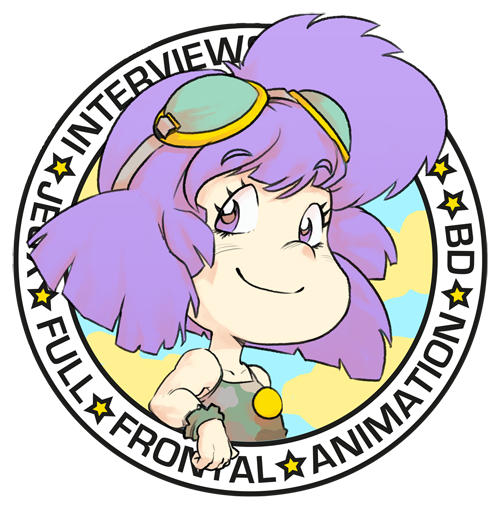
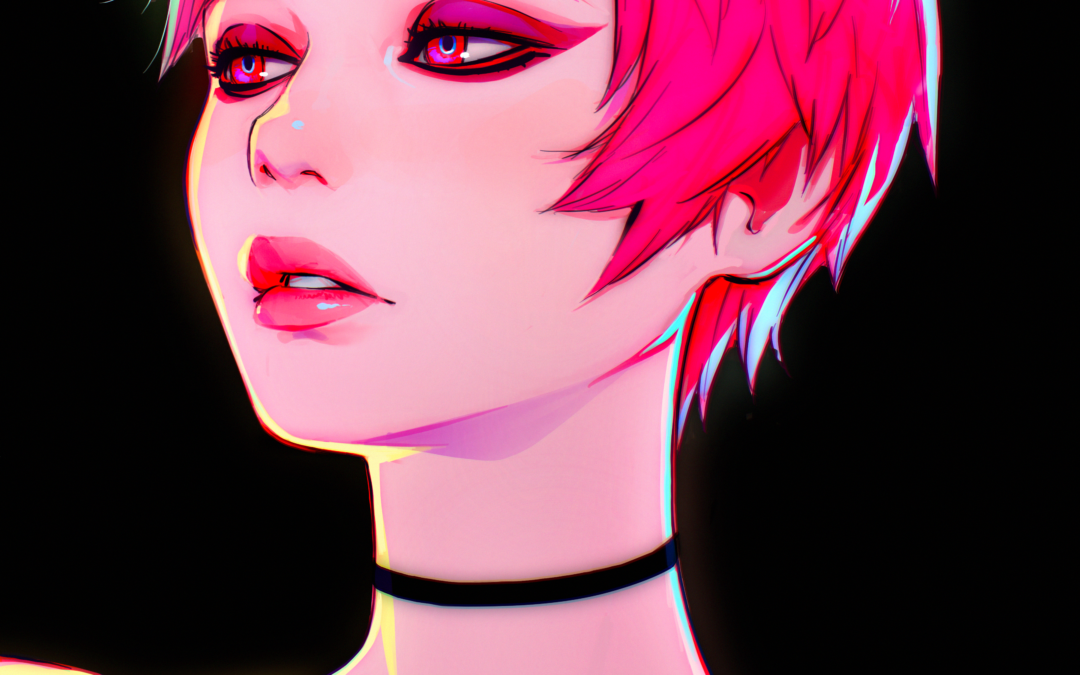
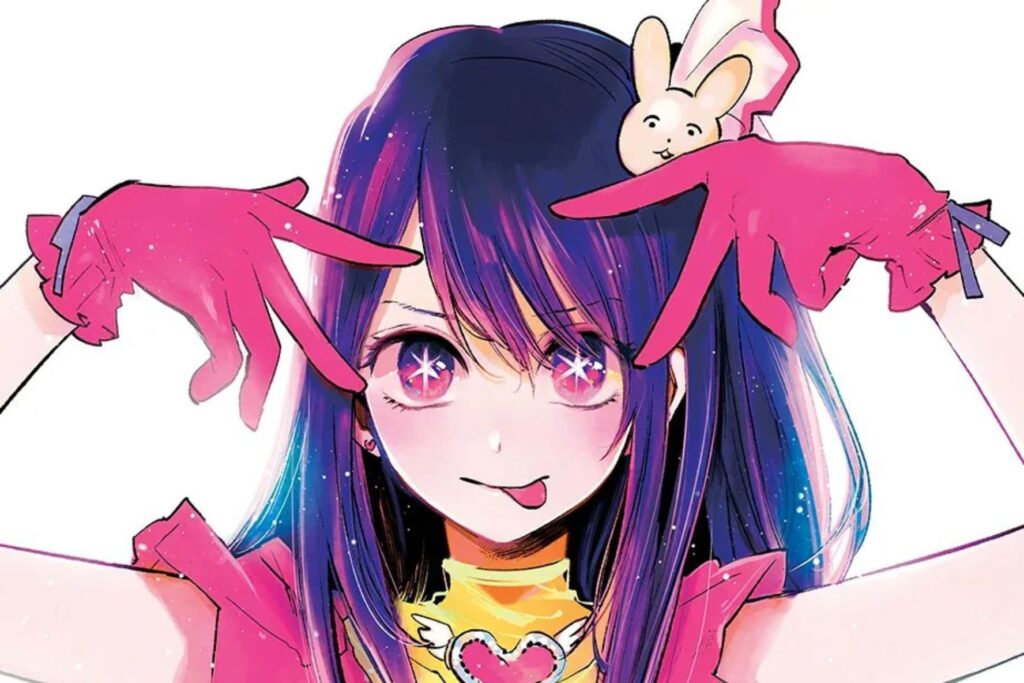
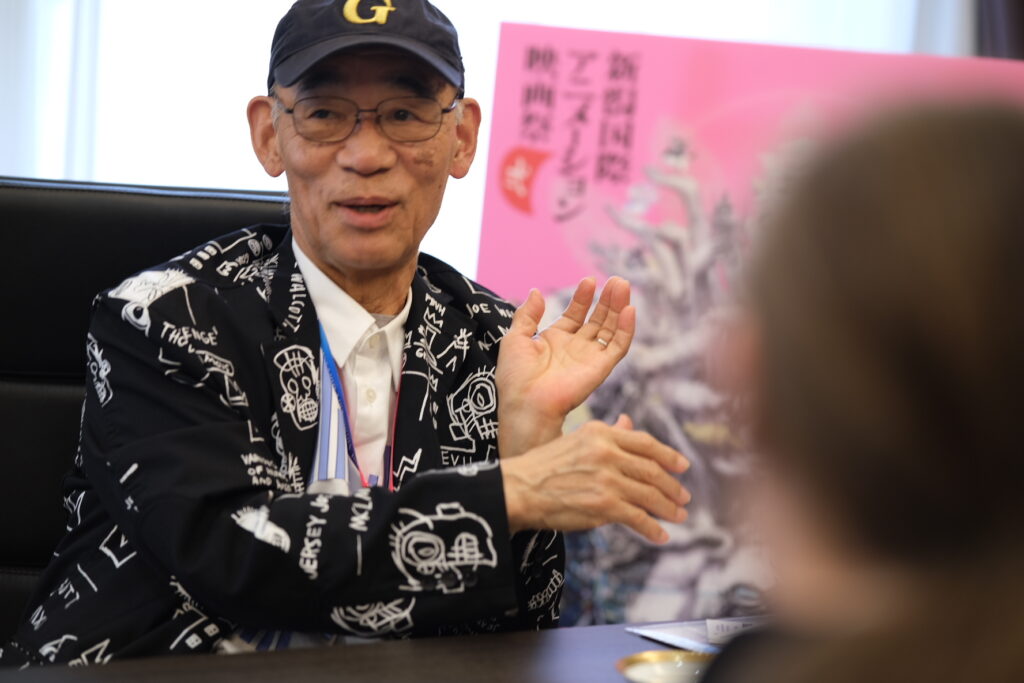
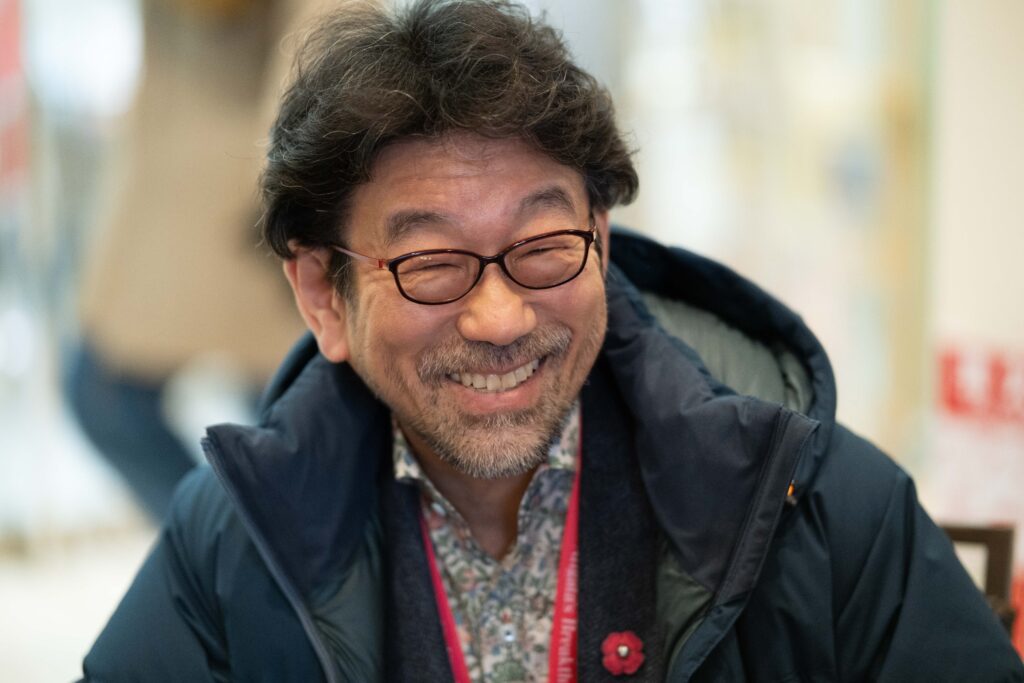
Trackbacks/Pingbacks